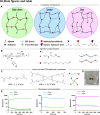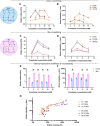This is a preprint.
Crosslinker Architectures Impact Viscoelasticity in Dynamic Covalent Hydrogels
- PMID: 38766044
- PMCID: PMC11100722
- DOI: 10.1101/2024.05.07.593040
Crosslinker Architectures Impact Viscoelasticity in Dynamic Covalent Hydrogels
Update in
-
Cross-Linker Architectures Impact Viscoelasticity in Dynamic Covalent Hydrogels.Adv Healthc Mater. 2024 Dec;13(30):e2402059. doi: 10.1002/adhm.202402059. Epub 2024 Oct 15. Adv Healthc Mater. 2024. PMID: 39407436
Abstract
Dynamic covalent crosslinked (DCC) hydrogels represent a significant advance in biomaterials for regenerative medicine and mechanobiology. These gels typically offer viscoelasticity and self-healing properties that more closely mimic in vivo tissue mechanics than traditional, predominantly elastic, covalent crosslinked hydrogels. Despite their promise, the effects of varying crosslinker architecture - side chain versus telechelic crosslinks - on the viscoelastic properties of DCC hydrogels have not been thoroughly investigated. This study introduces hydrazone-based alginate hydrogels and examines how side-chain and telechelic crosslinker architectures impact hydrogel viscoelasticity and stiffness. In hydrogels with side-chain crosslinking (SCX), higher polymer concentrations enhance stiffness and decelerates stress relaxation, while an off-stoichiometric hydrazine-to-aldehyde ratio leads to reduced stiffness and shorter relaxation time. In hydrogels with telechelic crosslinking, maximal stiffness and slowest stress relaxation occurs at intermediate crosslinker concentrations for both linear and star crosslinkers, with higher crosslinker valency further increasing stiffness and relaxation time. Our result suggested different ranges of stiffness and stress relaxation are accessible with the different crosslinker architectures, with SCX hydrogels leading to slower stress relaxation relative to the other architectures, and hydrogels with star crosslinking (SX) providing increased stiffness and slower stress relaxation relative to hydrogels with linear crosslinking (LX). The mechanical properties of SX hydrogels are more robust to changes induced by competing chemical reactions compared to LX hydrogels. Our research underscores the pivotal role of crosslinker architecture in defining hydrogel stiffness and viscoelasticity, providing crucial insights for the design of DCC hydrogels with tailored mechanical properties for specific biomedical applications.
Conflict of interest statement
Conflicts of interest There are no conflicts to declare.
Figures





References
-
- Cukierman E., Pankov R., Stevens D. R., Yamada K. M., Science (1979) 2001, 294, 1708. - PubMed
Publication types
Grants and funding
LinkOut - more resources
Full Text Sources
